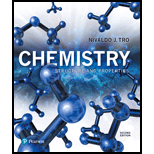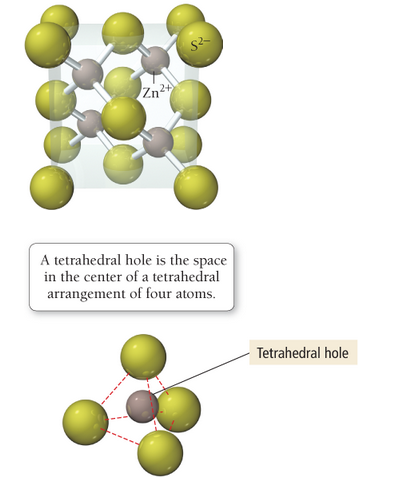
Mastering Chemistry with Pearson eText -- Standalone Access Card -- for Chemistry: Structure and Properties (2nd Edition)
2nd Edition
ISBN: 9780134566290
Author: Nivaldo J. Tro
Publisher: PEARSON
expand_more
expand_more
format_list_bulleted
Concept explainers
Textbook Question
Chapter 12, Problem 52E
Consider the zinc blende structure in Figure 12.14 What type of structure would result if the remaining tetrahedral sites in the unit cell were also filled with cations?

Expert Solution & Answer
Want to see the full answer?
Check out a sample textbook solution
Students have asked these similar questions
The table includes macrostates characterized by 4 energy levels (&) that are
equally spaced but with different degrees of occupation.
a) Calculate the energy of all the macrostates (in joules). See if they all have
the same energy and number of particles.
b) Calculate the macrostate that is most likely to exist. For this macrostate,
show that the population of the levels is consistent with the Boltzmann
distribution.
macrostate 1 macrostate 2 macrostate 3
ε/k (K) Populations
Populations
Populations
300
5
3
4
200
7
9
8
100
15
17
16
0
33
31
32
DATO: k = 1,38×10-23 J K-1
Don't used Ai solution
In an experiment, the viscosity of water was measured at different
temperatures and the table was constructed from the data obtained.
a) Calculate the activation energy of viscous flow (kJ/mol).
b) Calculate the viscosity at 30°C.
T/°C
0
20
40
60
80
η/cpoise 1,972 1,005 0,656 0,469 0,356
Chapter 12 Solutions
Mastering Chemistry with Pearson eText -- Standalone Access Card -- for Chemistry: Structure and Properties (2nd Edition)
Ch. 12 - What is graphene? Why is graphene unique?Ch. 12 - Prob. 2ECh. 12 - What is a crystalline lattice? How is the lattice...Ch. 12 - Prob. 4ECh. 12 - Prob. 5ECh. 12 - What is the difference between hexagonal closest...Ch. 12 - What are the three basic types of solids and the...Ch. 12 - Prob. 8ECh. 12 - What kinds of forces hold each of the three basic...Ch. 12 - Prob. 10E
Ch. 12 - In an ionic compound, how are the relative sizes...Ch. 12 - Prob. 12ECh. 12 - Show how the fluorite structure accommodates a...Ch. 12 - Prob. 14ECh. 12 - Prob. 15ECh. 12 - Prob. 16ECh. 12 - Prob. 17ECh. 12 - Prob. 18ECh. 12 - Prob. 19ECh. 12 - Describe the difference between vitreous silica...Ch. 12 - Prob. 21ECh. 12 - Prob. 22ECh. 12 - Prob. 23ECh. 12 - Prob. 24ECh. 12 - What is a polymer? What is the difference between...Ch. 12 - Prob. 26ECh. 12 - Prob. 27ECh. 12 - An X-ray beam of unknown wavelength is diffracted...Ch. 12 - Prob. 29ECh. 12 - Determine the coordination number for each...Ch. 12 - Calculate the packing efficiency of the...Ch. 12 - Prob. 32ECh. 12 - Prob. 33ECh. 12 - Molybdenum crystallizes with the body-centred unit...Ch. 12 - Rhodium has a density of 12.41 g / cm3 and...Ch. 12 - Barium has a density of 3.59 g/cm3 and...Ch. 12 - Prob. 37ECh. 12 - Palladium crystallizes with a face-centered cubic...Ch. 12 - Prob. 39ECh. 12 - Identify each solid as molecular, ionic, or...Ch. 12 - Which solid has the highest melting point? Why?...Ch. 12 - Which solid has the highest melting point? Why?...Ch. 12 - Which solid in each pair has the higher melting...Ch. 12 - Which solid in each pair has the higher melting...Ch. 12 - Prob. 45ECh. 12 - Prob. 46ECh. 12 - The unit cells for cesium chloride and barium(ll)...Ch. 12 - Prob. 48ECh. 12 - Prob. 49ECh. 12 - Prob. 50ECh. 12 - Prob. 51ECh. 12 - Consider the zinc blende structure in Figure 12.14...Ch. 12 - Prob. 53ECh. 12 - Prob. 54ECh. 12 - Prob. 55ECh. 12 - What are the name and formula of the compound...Ch. 12 - Prob. 57ECh. 12 - Prob. 58ECh. 12 - Prob. 59ECh. 12 - Prob. 60ECh. 12 - Prob. 61ECh. 12 - How many molecular orbitals are present in the...Ch. 12 - Prob. 63ECh. 12 - Prob. 64ECh. 12 - Prob. 65ECh. 12 - Prob. 66ECh. 12 - Prob. 67ECh. 12 - Prob. 68ECh. 12 - Prob. 69ECh. 12 - Saran, the polymer used to make saran wrap, is an...Ch. 12 - One kind of polyester is a condensation copolymer...Ch. 12 - Nomex, a condensation copolymer used by...Ch. 12 - Prob. 73ECh. 12 - Polyacrylonitrile (PAN) is an addition polymer...Ch. 12 - Prob. 75ECh. 12 - Prob. 76ECh. 12 - Prob. 77ECh. 12 - Prob. 78ECh. 12 - Prob. 79ECh. 12 - Prob. 80ECh. 12 - Prob. 81ECh. 12 - The density of an unknown metal is 12.3 g/cm3 and...Ch. 12 - An unknown metal is found to have a density of...Ch. 12 - Prob. 84ECh. 12 - Prob. 85ECh. 12 - Prob. 86ECh. 12 - Prob. 87ECh. 12 - Prob. 88ECh. 12 - Prob. 89ECh. 12 - Prob. 90ECh. 12 - Prob. 91ECh. 12 - Perovskite is a compound with a cubic unit cell...Ch. 12 - Prob. 93ECh. 12 - Despite Dalton's laws, it is now known that many...Ch. 12 - During the glass manufacturing process, the liquid...Ch. 12 - Why are X-rays used for crystallography? Why not...Ch. 12 - Compare the crystal structure of diamond (C) and...Ch. 12 - Prob. 98ECh. 12 - Prob. 99ECh. 12 - Have each group member select one of the cubic...Ch. 12 - Prob. 101ECh. 12 - Prob. 102ECh. 12 - Prob. 103ECh. 12 - Prob. 104ECh. 12 - Prob. 105ECh. 12 - Prob. 1SAQCh. 12 - A crystalline solid has a body-centered cubic...Ch. 12 - Prob. 3SAQCh. 12 - Prob. 4SAQCh. 12 - Prob. 5SAQCh. 12 - Prob. 6SAQCh. 12 - Prob. 7SAQCh. 12 - Prob. 8SAQCh. 12 - Prob. 9SAQCh. 12 - Prob. 10SAQCh. 12 - Prob. 11SAQCh. 12 - Prob. 12SAQCh. 12 - Prob. 13SAQCh. 12 - Prob. 14SAQCh. 12 - Prob. 15SAQ
Knowledge Booster
Learn more about
Need a deep-dive on the concept behind this application? Look no further. Learn more about this topic, chemistry and related others by exploring similar questions and additional content below.Similar questions
- Don't used Ai solutionarrow_forwardLet's see if you caught the essentials of the animation. What is the valence value of carbon? a) 4 b) 2 c) 8 d) 6arrow_forwardA laser emits a line at 632.8 nm. If the cavity is 12 cm long, how many modes oscillate in the cavity? How long does it take for the radiation to travel the entire cavity? What is the frequency difference between 2 consecutive modes?(refractive index of the medium n = 1).arrow_forward
- A laser emits a line at 632.8 nm. If the cavity is 12 cm long, how many modes oscillate in the cavity? How long does it take for the radiation to travel the entire cavity? What is the frequency difference between 2 consecutive modes?(refractive index of the medium n = 1).arrow_forwardThe number of microstates corresponding to each macrostate is given by N. The dominant macrostate or configuration of a system is the macrostate with the greatest weight W. Are both statements correct?arrow_forwardFor the single step reaction: A + B → 2C + 25 kJ If the activation energy for this reaction is 35.8 kJ, sketch an energy vs. reaction coordinate diagram for this reaction. Be sure to label the following on your diagram: each of the axes, reactant compounds and product compounds, enthalpy of reaction, activation energy of the forward reaction with the correct value, activation energy of the backwards reaction with the correct value and the transition state. In the same sketch you drew, after the addition of a homogeneous catalyst, show how it would change the graph. Label any new line "catalyst" and label any new activation energy.arrow_forward
arrow_back_ios
SEE MORE QUESTIONS
arrow_forward_ios
Recommended textbooks for you
 Physical ChemistryChemistryISBN:9781133958437Author:Ball, David W. (david Warren), BAER, TomasPublisher:Wadsworth Cengage Learning,
Physical ChemistryChemistryISBN:9781133958437Author:Ball, David W. (david Warren), BAER, TomasPublisher:Wadsworth Cengage Learning, Chemistry & Chemical ReactivityChemistryISBN:9781337399074Author:John C. Kotz, Paul M. Treichel, John Townsend, David TreichelPublisher:Cengage Learning
Chemistry & Chemical ReactivityChemistryISBN:9781337399074Author:John C. Kotz, Paul M. Treichel, John Townsend, David TreichelPublisher:Cengage Learning Principles of Modern ChemistryChemistryISBN:9781305079113Author:David W. Oxtoby, H. Pat Gillis, Laurie J. ButlerPublisher:Cengage Learning
Principles of Modern ChemistryChemistryISBN:9781305079113Author:David W. Oxtoby, H. Pat Gillis, Laurie J. ButlerPublisher:Cengage Learning- Chemistry: Matter and ChangeChemistryISBN:9780078746376Author:Dinah Zike, Laurel Dingrando, Nicholas Hainen, Cheryl WistromPublisher:Glencoe/McGraw-Hill School Pub Co
 Chemistry for Engineering StudentsChemistryISBN:9781337398909Author:Lawrence S. Brown, Tom HolmePublisher:Cengage Learning
Chemistry for Engineering StudentsChemistryISBN:9781337398909Author:Lawrence S. Brown, Tom HolmePublisher:Cengage Learning Chemistry & Chemical ReactivityChemistryISBN:9781133949640Author:John C. Kotz, Paul M. Treichel, John Townsend, David TreichelPublisher:Cengage Learning
Chemistry & Chemical ReactivityChemistryISBN:9781133949640Author:John C. Kotz, Paul M. Treichel, John Townsend, David TreichelPublisher:Cengage Learning

Physical Chemistry
Chemistry
ISBN:9781133958437
Author:Ball, David W. (david Warren), BAER, Tomas
Publisher:Wadsworth Cengage Learning,

Chemistry & Chemical Reactivity
Chemistry
ISBN:9781337399074
Author:John C. Kotz, Paul M. Treichel, John Townsend, David Treichel
Publisher:Cengage Learning

Principles of Modern Chemistry
Chemistry
ISBN:9781305079113
Author:David W. Oxtoby, H. Pat Gillis, Laurie J. Butler
Publisher:Cengage Learning

Chemistry: Matter and Change
Chemistry
ISBN:9780078746376
Author:Dinah Zike, Laurel Dingrando, Nicholas Hainen, Cheryl Wistrom
Publisher:Glencoe/McGraw-Hill School Pub Co

Chemistry for Engineering Students
Chemistry
ISBN:9781337398909
Author:Lawrence S. Brown, Tom Holme
Publisher:Cengage Learning

Chemistry & Chemical Reactivity
Chemistry
ISBN:9781133949640
Author:John C. Kotz, Paul M. Treichel, John Townsend, David Treichel
Publisher:Cengage Learning
Unit Cell Chemistry Simple Cubic, Body Centered Cubic, Face Centered Cubic Crystal Lattice Structu; Author: The Organic Chemistry Tutor;https://www.youtube.com/watch?v=HCWwRh5CXYU;License: Standard YouTube License, CC-BY